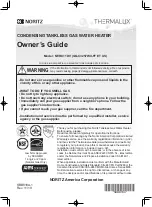
1. Do not attempt to install, repair or service this heater
or the gas supply line unless you have continuing
expert training and knowledge of gas heaters.
Qualifications for service and installation of this
equipment are as follows:
QUALIFICATIONS FOR
SERVICING AND INSTALLATION:
a. To be a qualified gas heater service person, you
must have been trained in gas-fired heater
ser vicing, repair and also have suf ficient
experience to allow you to troubleshoot, replace
defective parts, and test heaters in order to get
them into a continuing safe and normal operation
condition. You must completely familiarize
yourself with each model heater by reading and
complying with the safety instructions, labels,
owner’s manual, etc. that is provided with each
heater.
b. To be a qualified gas installation person, you must
have sufficient training and experience to handle
all aspects of installing, repairing and altering gas
lines, including selecting and installing the proper
equipment, and selecting proper pipe size to be
used. This must be done in accordance with all
local, state and national codes as well as the
manufacturer’s requirements.
2. All installations or applications of L. B. White Co.,
Inc.’s radiant heater and associated zone control
panel should meet the requirements of local, state
and national L.P. gas and natural gas, electrical and
safety codes. Your gas supplier, local licensed
electrician, local fire department and government
agencies can help you determine these requirements.
In the absence of local codes, comply with the
following:
-- ANSI/NFPA 58, latest edition, Standard for
Storage and Handling of Liquefied Petroleum
Gas and/or
-- ANSI Z223.1/NFPA 54, National Fuel Gas
Code
-- ANSI/NFPA 70, National Electrical Code.
3. If at any time you notice something unusual about the
operation of your heater such as gas odor,
overheating, flames other than in the combustion
cone area, etc., evacuate the area immediately and
call your fire department and your gas service
agency. Get assurances from the fire department
that the area is free of gas before you attempt to
relight the heater.
4. The components on the heater that call for hand
operation should work with hand pressure only. If
more force is required, have a qualified gas heater
service agency replace the complete part. Do not
attempt to repair.
5. This heater is intended for the heating of livestock in
agricultural animal confinement buildings only. The
heater shall only be mounted inside the animal
confinement building. It shall not be used for outside
heating applications.
6. Do not locate fuel gas containers or fuel supply hoses
anywhere within the heating zone of the heater.
7. Do not block the air intake, burner venturi tube or
burner cone area. Doing so may cause improper
combustion or damage to the heater components,
leading to property damage or animal loss.
8. Do not move, handle, or service the heater while in
operation or connected to fuel supply.
9. The hose assembly providing fuel to the heater must
be inspected on a regular basis. This should be done
at least once a year, or when the building is cleaned
out. If it is evident there is excessive abrasion or
wear, or if the hose is cut, it must be replaced prior to
heater being put into operation. The hose assembly
shall be protected from animals, building materials,
and contact with hot surfaces during use. The hose
assembly shall be that specified by the manufacturer.
See parts list.
10. Check for gas leaks and proper function upon
installation, before building repopulation and when
relocating.
11. If the gas flow is interrupted and the burner flame is
extinguished, immediately shut off the gas. Do not
relight the heater until you are sure that all of the gas
that may have accumulated through the brooder has
cleared away. Do not relight the heater until at least
five minutes have passed.
12. If the heater is to be relocated, make sure that all gas
connections are capped and the gas supply is shut
off. All connection points must be leak checked after
disconnection and after reconnection.
13. The grower shall inspect the heater before building
repopulation. Such inspection should consist of, but
is not limited to, the following points of action:
6
WARNING
Burn H
Hazard
Can ccause pproperty ddamage, ssevere iinjury oor ddeath.
■
The heater’s combustion cones and canopy are
extremely hot during operation and shortly after
shutting down.
■
Always be aware of your proximity to the heater and
avoid contact with its hot surfaces during or shortly
after operation.
■
Failure to follow this warning can result in burns
leading to severe personal injury.
Safety Precautions
Summary of Contents for I17
Page 2: ......








































